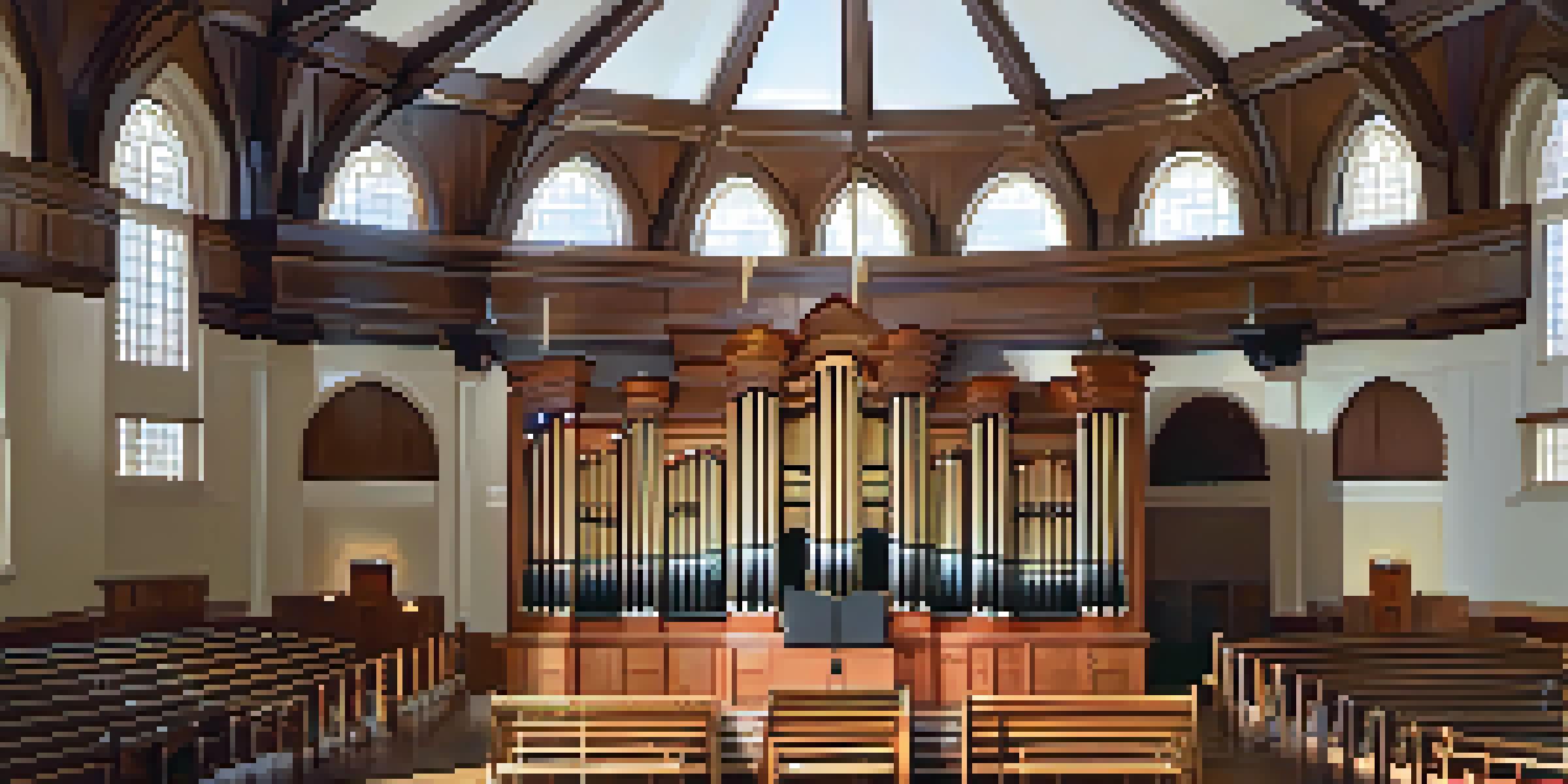Architectural Wonders of Salt Lake City: Historic Landmarks

The Majestic Salt Lake Temple: A Symbol of Faith
The Salt Lake Temple stands as an iconic representation of the city's heritage, constructed by the Church of Jesus Christ of Latter-day Saints. Its intricate Gothic and Romanesque architectural style captivates visitors and locals alike, with its towering spires reaching towards the heavens. This magnificent structure, completed in 1893, is not just a place of worship but a symbol of the faith and determination of the early settlers.
Architecture is a visual art, and the buildings speak for themselves.
As you approach the temple, you can't help but admire the craftsmanship that went into every detail, from the granite blocks to the stunning stained glass windows. The surrounding Temple Square offers lush gardens and fountains, making it a serene spot for reflection and exploration. Whether you're looking for spiritual insight or simply enjoying the beauty of the architecture, the Salt Lake Temple is a must-visit landmark.
Guided tours are available for those interested in learning more about the temple's history and significance. The temple's construction took 40 years, involving dedicated artisans and laborers, showcasing the community's commitment to their faith. It's a place where history and spirituality intertwine, leaving a lasting impression on all who visit.
The Utah State Capitol: A Beacon of Governance
Perched atop Capitol Hill, the Utah State Capitol is a stunning example of neoclassical architecture, embodying the spirit of democracy. Completed in 1916, this grand building features a majestic dome that towers over the city, symbolizing the state's governance and aspirations. Walking through its halls, you'll find beautifully adorned chambers and striking murals that tell the story of Utah’s rich heritage.

The exterior is equally impressive, clad in white Colorado Yule marble, which gleams under the Utah sun. Visitors can stroll through the surrounding grounds, adorned with sculptures and monuments that honor influential figures in Utah's history. The Capitol offers breathtaking views of the Salt Lake Valley, making it a perfect spot for photography enthusiasts.
Salt Lake Temple: Faith and Heritage
The Salt Lake Temple is a magnificent symbol of faith and determination, showcasing intricate architecture and a deep historical significance.
Guided tours are available to delve deeper into the building's architectural significance and the legislative process. From the grand staircase to the intricate ceilings, every aspect of the Capitol is designed to inspire awe and respect for the democratic process. It's not just a building; it's a testament to the values and history of the state.
The Historic Tabernacle: A Musical Marvel
The Tabernacle, located on Temple Square, is renowned for its exceptional acoustics and unique architecture, making it a musical gem in Salt Lake City. Completed in 1867, this oval-shaped building features a distinctive wooden dome that draws visitors in with its beauty and acoustic perfection. It serves as the home of the famous Mormon Tabernacle Choir, known for its rich harmonies and performances.
A building has two lives. The one it lives and the one it should live.
Inside, the expansive seating and stunning organ, one of the largest in the world, create an atmosphere that enhances every musical performance. The Tabernacle's design reflects the ingenuity of early settlers who wanted to create a space that could accommodate large gatherings and musical events. It's a place where music and architecture beautifully converge, leaving a lasting impact on all who enter.
Attending a concert or a religious service at the Tabernacle offers a unique experience, allowing you to appreciate both the acoustics and the historical significance. The building has withstood the test of time, enduring earthquakes and renovations, yet it remains a beloved landmark. Visitors often leave with a sense of awe, not only at the music but at the architectural wonder surrounding them.
The Salt Lake City Library: A Modern Architectural Marvel
The Salt Lake City Public Library is a striking blend of modern design and functionality, making it a standout in the urban landscape. Opened in 2003, its unique, curvilinear structure is not only visually appealing but also designed for sustainability and community engagement. The library’s terraces and gardens create a serene environment for reading and reflection amidst the bustling city.
Inside, the library boasts a vast collection of books, multimedia resources, and spaces for events, study, and collaboration. The open layout encourages exploration, with natural light flooding through large windows, creating an inviting atmosphere. It's a space where architecture meets community needs, offering a safe haven for learning and creativity.
Utah State Capitol: Democracy's Home
The Utah State Capitol stands as a neoclassical architectural marvel that embodies the spirit of governance and the rich history of Utah.
The library is also a hub for various cultural and educational activities, hosting workshops, exhibits, and lectures. Its design has received numerous accolades, reflecting the community's commitment to creating a space that fosters knowledge and collaboration. Visiting the library is not just about borrowing books; it’s about experiencing a modern architectural wonder that serves as a beacon of learning.
The Historic Eagle Gate: A Gateway to the Past
Eagle Gate is a historic landmark that symbolizes the entrance to Salt Lake City, showcasing the city's rich pioneer heritage. Built in 1859, this impressive wooden archway features intricate carvings and a majestic eagle perched atop, welcoming visitors to the city. Originally constructed as a toll gate, it now serves as a reminder of the city's early days and its journey through time.
As you pass under the gate, you can almost hear the echoes of history, imagining the pioneers who once traversed this path. The gate's design reflects the Victorian style popular during its construction, making it a notable feature in the urban landscape. It's a perfect spot for photos, capturing the essence of Salt Lake City’s history against a backdrop of modern development.
Today, Eagle Gate stands as a testament to the city's growth and resilience, celebrating the spirit of the pioneers who shaped the area. Community events often take place nearby, fostering a connection between the past and present. When visiting, take a moment to appreciate this architectural gem and the stories it holds within its wooden frame.
The Historic City and County Building: A Civic Masterpiece
The City and County Building is a stunning example of Romanesque Revival architecture, sitting proudly in the heart of Salt Lake City. Completed in 1894, its intricate stonework and distinctive clock tower make it a favorite among both locals and tourists. This building is not just a seat of government; it’s a symbol of civic pride and historical significance.
Walking through its grand entrance, visitors are greeted by ornate details, including elaborate chandeliers and beautiful murals that depict the region’s history. The building serves as a venue for various civic events and public functions, making it a lively part of the community. Its design is a nod to the city’s aspirations during the late 19th century, reflecting the values of that era.
Grand Hotel Utah: Luxury and History
The Grand Hotel Utah combines early 20th-century elegance with modern amenities, making it a luxurious historical landmark in the heart of the city.
The City and County Building is also a popular spot for photography, especially during the winter months when the snow blankets its steps. Guided tours offer insights into the building's architectural features and its role in local governance. It’s more than just a structure; it’s a living part of Salt Lake City’s identity, connecting past, present, and future.
The Old Salt Lake City Post Office: A Historic Hub
The Old Salt Lake City Post Office, completed in 1892, is a beautiful example of Richardsonian Romanesque architecture, showcasing the city’s growth during the late 19th century. With its imposing stone façade and intricate detailing, it stands as a reminder of the importance of communication and connection in the community. Though it no longer serves as a post office, it remains a beloved landmark.
The building's design is characterized by its rounded arches and robust structure, making it a notable feature in the downtown area. Visitors are often struck by its historical significance and the stories it holds, from the bustling mail deliveries of the past to its current role as a site for various events and gatherings. Its architecture embodies the spirit of progress and community.

Today, the Old Post Office is often used for art exhibits and public events, allowing locals and visitors to engage with its history in a contemporary context. Its preservation reflects the city's commitment to honoring its architectural heritage while adapting to modern needs. When you stand before this historic building, you can feel the pulse of history, connecting the past with the present.
The Grand Hotel Utah: A Luxurious Historical Landmark
The Grand Hotel Utah is not just a place to stay; it’s a piece of history that embodies the elegance of early 20th-century architecture. Opened in 1911, this luxurious hotel features beautiful Beaux-Arts design elements, making it a landmark in the city. Its grand lobby and stunning chandeliers create an atmosphere of sophistication that attracts visitors from around the world.
The hotel has hosted numerous dignitaries and celebrities over the years, making it a significant part of Salt Lake City’s social fabric. With its prime location near Temple Square and other attractions, it provides a perfect base for exploring the city. The hotel's attention to detail in both architecture and service ensures that every guest feels like royalty.
Today, the Grand Hotel Utah continues to be a symbol of hospitality and luxury, blending modern amenities with historical charm. Its preservation and ongoing relevance in the community highlight the importance of maintaining architectural heritage. When you step inside, you’re not just entering a hotel; you’re walking into a story that spans over a century, filled with elegance and history.